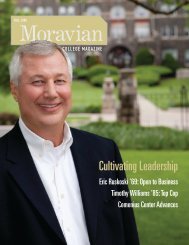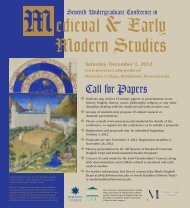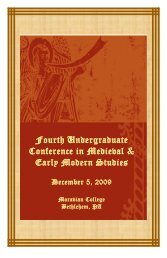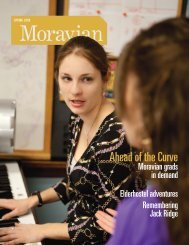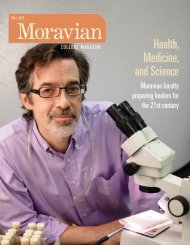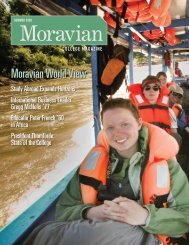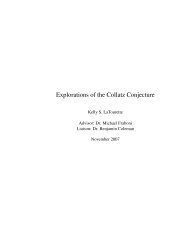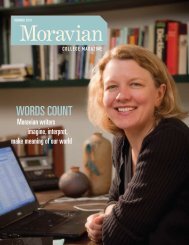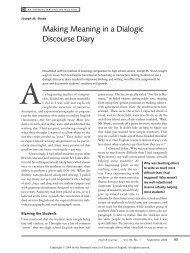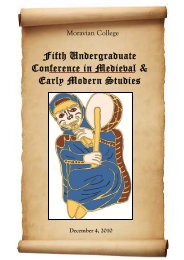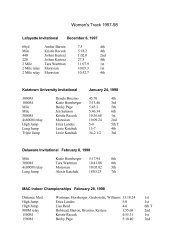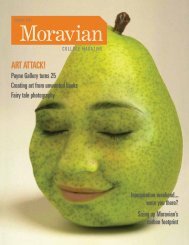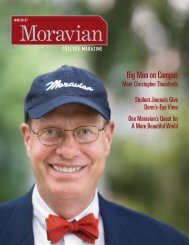You also want an ePaper? Increase the reach of your titles
YUMPU automatically turns print PDFs into web optimized ePapers that Google loves.
What’s the Big Deal about ALGAE?<br />
Yi Li ’08 was new to <strong>Moravian</strong>, wandering the hallways of Collier Hall of Science, when she felt an urge to<br />
knock on the door of the new chair of the Biology Department. To her delight, Professor Diane Husic responded.<br />
The two spoke excitedly about Yi’s research hopes, and as quickly as that, a research bond was formed.<br />
That’s the kind of thing that can happen at<br />
<strong>Moravian</strong>—and does.<br />
The result was that during her sophomore<br />
year, Yi Li was pursuing the mysteries of a<br />
species of algae—Chlamydomonas reinhardtii<br />
to be precise—that had engaged Professor<br />
Husic’s attention since graduate school. Singlecell<br />
organisms such as these probably long<br />
ago made the transition from water to land.<br />
The clues as to how they may have adapted to<br />
the terrestrial environment and led to the<br />
development of plants may exist within these<br />
particular algal cells.<br />
Yi became the talented assistant to Professor<br />
Husic and Lehigh University scientists working<br />
to fi nd what mechanism propelled tiny water<br />
dwellers to advance the cause of evolution by<br />
taking up residence on land.<br />
The research zeroed in on certain genes that<br />
enable a chain reaction of adaptation. They<br />
contain the information to produce enzymes<br />
that might make it possible for the organism to<br />
adapt its chemical reactions to make possible<br />
living in a radically different environment on<br />
the shore, surrounded by a gaseous atmosphere<br />
containing a relatively high level of oxygen<br />
compared to what exists in water. “This alga,”<br />
Professor Husic says, “represents a link between<br />
completely aquatic organisms and higher plants.<br />
We are trying to unlock that transition.” Vital<br />
information from the recently completed genetic<br />
map has greatly boosted the chances for success,<br />
she adds.<br />
Yi Li was ready for the sophisticated task. She<br />
comes from China, not too far from Beijing.<br />
She considered many options before deciding<br />
to follow a biochemistry future. She was once<br />
enrolled as a sociology student, and had also<br />
thought of becoming an ambassador or a veterinarian.<br />
She says she now feels at home in the<br />
lab, making and recording precise observations.<br />
Her commitment to science was made in the<br />
summer of 2005, when she was given the<br />
opportunity to immerse herself in research full<br />
time for ten weeks under Professor Husic’s<br />
direction. That research has continued to the<br />
present time.<br />
Her career goal involves another kind of<br />
transition: from laboratory to skin. She plans<br />
to make chemical substances within the<br />
cosmetics industry.<br />
Sarah Mueller ’06 not only took part in a biology experiment that was high-level; she pursued research that has potential for helping<br />
defeat Parkinson’s disease. Sarah worked with Cecilia M. Fox, assistant professor of biology, on a process by which use of the<br />
chemical element selenium may be an important factor in preventing “free radical” molecules from destroying dopamine neurons,<br />
thereby interfering with the progression of the disease. The results were encouraging, she says, and “very exciting.”



